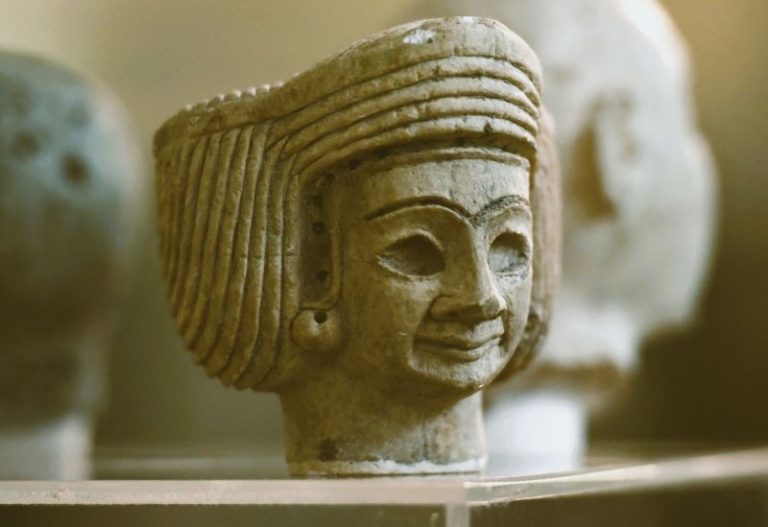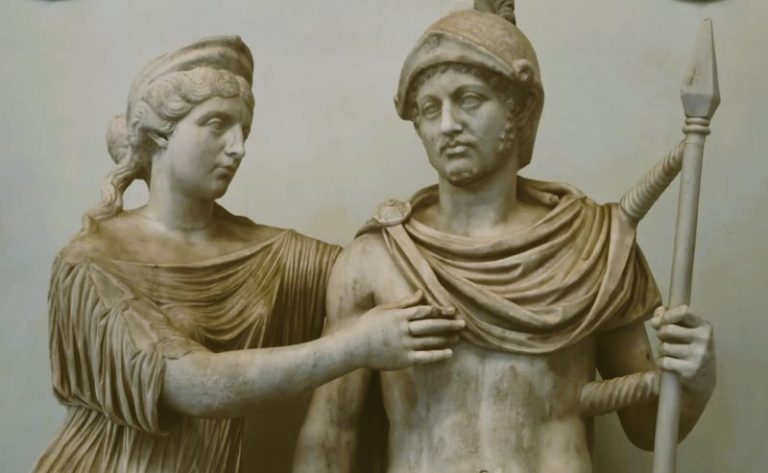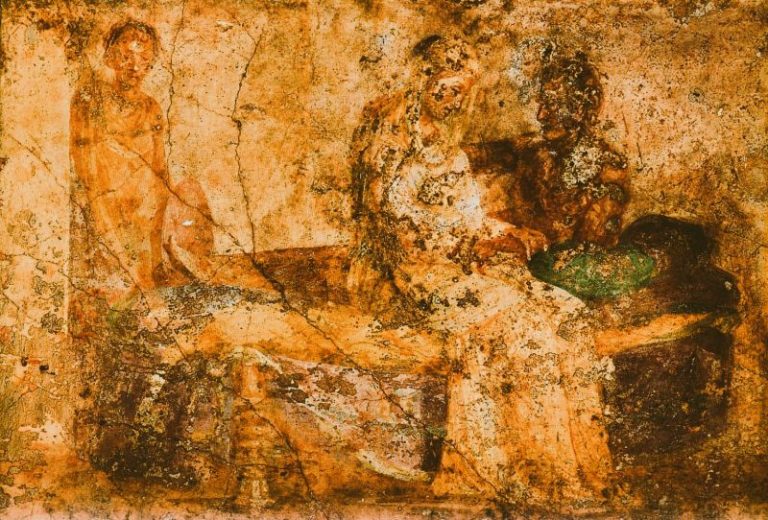
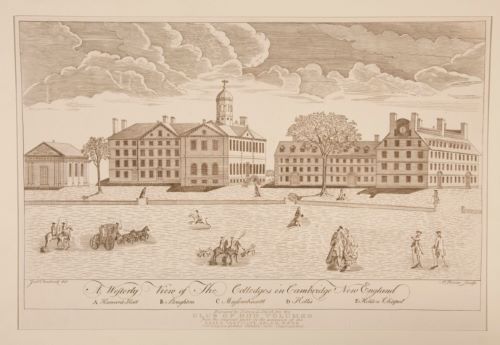
Shifts in industrial organization and political economy.

By Dr. Claudia Goldin
Lee and Ezpeleta Professor of Arts and Sciences
Henry Lee Professor of Economics
Harvard University
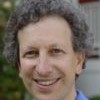
By Dr. Lawrence F. Katz
Elisabeth Allison Professor of Economics
Harvard University
Introduction
Higher education in the United States today has several salient characteristics: the large average size of its institutions; the coexistence of small liberal arts colleges and large research universities; the substantial share of enrollment in the public sector; a viable and long-lived private sector; professional schools that are typically embedded within universities; and varying levels of per capita funds provided by the states. Many of these features are often described as having been an outgrowth of post-World War II developments, such as the G.I. Bill, the rise of federal funding for higher education, and the arrival of higher education for the masses. This paper will argue, to the contrary, that the formative period of America’s higher education industry, when its modern form took shape, was actually during the several decades after 1890.1
The shifts in the formative years profoundly altered the higher education industry. The decade around the turn of the 20th century witnessed the flourishing of the American research university and the emergence of public sector institutions as leaders in educational quality. In the subsequent two to three decades, institutions of higher education vastly increased in scale, particularly those in the public sector, and public sector institutions greatly expanded their enrollments relative to their private counterparts. Universities widened their scope of operations by adding a multitude of highly specialized departments. Professional schools, which had been mainly independent entities, became embedded in universities. Denominational institutions, particularly schools of theology, went into absolute decline, and small liberal arts colleges into relative decline. Something profoundly altered higher education around 1890 so that almost all of today’s noteworthy U.S. universities and colleges were founded before 1900.
This paper describes the shifts in industrial organization and political economy during the formative years of higher education from 1890 to 1940, some of the reasons for them, and a few of the consequences. We begin with a discussion of the ‘‘technological shocks’’ that swept the ‘‘knowledge industry’’ in the late 19th and early 20th centuries. These changes are crucial to understanding why the structure of the higher education industry changed so abruptly from the 1890s to the 1920s, in terms of the increased scale of higher education, its widened scope, the relative rise of public sector enrollments, and the commitment of particular states to higher education. We next discuss enrollments and the founding dates of institutions, along with other descriptive data, to give a sense of the growth of the industry’s f irms and clientele during the 1890 to 1940 period. We examine the political economy of higher education; in particular, why the public sector grew relative to the private sector and what factors determined cross-state variation in funding higher education from 1890 to 1940. In the conclusion, we turn to some of the consequences of publicly funded higher education.
Higher Education before World War II
Background: Changes in the Structure, Creation, and Diffusion of Knowledge
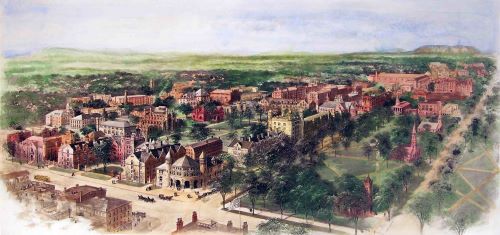
The business of colleges and universities is the creation and diffusion of knowledge. The structure of knowledge—by which we mean what was known and how it was packaged into disciplines—changed radically in the late 19th and early 20th centuries. These changes, in turn, expanded the optimal scale and scope of institutions of higher education and gave an advantage to certain institutions, particularly those in the public sector.
In the latter part of the 19th century, an increasing number of subjects taught in colleges and universities became subdivided and specialized, and those who taught began to define themselves as occupying separate, specialized fields. In each subject, these changes were brought about by somewhat different factors and at slightly different moments in time. Yet several factors are common to most. They include the application of science to industry, the growth of the scientific and experimental methods, and an increased awareness of social problems brought about by an increasingly industrial and urban society.
In industry after industry, in the late 19th century, there emerged a growing importance of chemistry and physics, most notably in the manufacture of steel, rubber, chemicals, sugar, drugs, nonferrous metals, petroleum, and goods directly involved in the use or production of electricity (Kevles, 1979). Firms that had not previously hired trained chemists and physicists did so at an increasing rate, as did the federal and state governments. The number of chemists employed in the U.S. economy increased by more than six-fold between 1900 and 1940 and by more than three-fold as a share of the labor force; the number of engineers increased by more than seven-fold over the same period (Kaplan and Casey, 1958, table 6). Science replaced art in production; the professional replaced the tinkerer as producer.
With greater demand for trained scientists, universities expanded their offerings. With new research findings, the classical scientific disciplines became increasingly fragmented, resulting in greater specialization. Greater specialization in biology was driven by changes in empiricism and experimentation earlier stimulated by the appearance of Darwin’s Origin of Species (Allen, 1979). Analogous changes appeared in the agricultural sciences. But here part of the impetus was the expanding crop variety in the United States as the railroad spurred cultivation clear across the continent, resulting in the growth of highly specialized farming (Rossiter, 1979). Even the social sciences expanded and splintered in the late 19th and early 20th centuries. They were given a mission by the growing social problems of industry, cities, immigration, and prolonged depressions, first in the 1870s and later in the 1890s. They were shaped by Darwinian thought, Mendelian genetics, and later by the increased role of statistics, testing, and empiricism generally (Ross, 1979).
To illustrate the increasing specialization in academic disciplines we explored the numbers of ‘‘learned societies’’ founded over time, where, according to one expert, a learned society is (Kiger, 1963, p. 2):
. . . an organization composed of individuals devoted to a particular learned discipline or branch or group of disciplines in the humanities, social sciences, or natural sciences and primarily committed to the study and acquisition of knowledge in such discipline. [It] excludes professional societies in medicine, law, engineering, etc., where the raison d’etre and primary emphasis is upon the application of knowledge for professional and/or pecuniary purposes . . .
Our sample consists of all national learned societies existing in the United States in about 1980, when Kiger (1982) wrote his last volume on the subject, and those that are current members of the American Council of Learned Societies.2 Five learned societies came into existence in the 100 years following the founding of the first—the American Philosophical Society in 1743—and an additional six appeared before 1880. Then the pace picked up and 16 such societies came into existence from 1880 to 1899. Another 28 followed in the next 20 years, from 1900 to 1919. Just 10 appeared from 1920 to 1939, although 20 were founded in the 1940 to 1959 period. The final 20-year period in the data set—1960 to 1979— contains 12 more. The point is clear: the greatest period of founding of learned societies was the first several decades of the 20th century during the time of disciplinary proliferation in the U.S. academy.
The expansion is evident in the social sciences. Economists formed their society in 1885 and the rest quickly followed: psychologists in 1892, anthropologists in 1902, political scientists in 1903, and sociologists in 1905. The biological and chemical fields also proliferated in the 1890 to 1910 period, when societies were formed for botanists, microbiologists, pathologists, electrochemists, and biological chemists, to mention a few.
These ‘‘technological shocks’’ in the structure of knowledge had far-reaching implications for ‘‘firms’’ in the knowledge industry. Before this transition, during the early to mid-19th century, institutions of higher education were often staffed by a mere handful of faculty, at least one of whom was proficient in ancient languages and religion whereas the rest were sufficiently informed to teach philosophy and history. A member of the group would be the college’s president, and he would handpick the other faculty. But as a number of previous historians have argued, the higher education sector in the United States changed fundamentally and took on its modern features between about 1890 and 1910. For example, Hofstadter and Hardy (1952, p. 31) write that ‘‘by 1910 the American university as an institution had taken shape,’’ and Veysey (1965) discusses how various factors, such as the rise of the research university and the increase in vocational subjects had become accepted facts of higher education by 1910. All changed as the scientific method, practically-oriented courses, the ‘‘lecture method’’ of teaching (Handlin and Handlin, 1970), and specialization in a host of dimensions swept the world of knowledge (for example, Bates, 1965; Kimball, 1992; Oleson and Voss, 1979).
The era of the division of labor in higher education had arrived. No longer could a respectable college survive with a mere handful of faculty. No longer could the college president keep abreast of all of his faculty’s teaching interests (and morality). Most of the changes served to increase economies of scale in the production of higher education services and thus push out the minimum number of faculty and students required for a college to remain viable. Also important to the story at hand is that in the universities that swept the landscape of higher education beginning in the late 19th century, those who diffused knowledge increasingly became its creators. Research became the handmaiden of teaching that we believe it is today.
Enrollments and Institutional Founding Dates
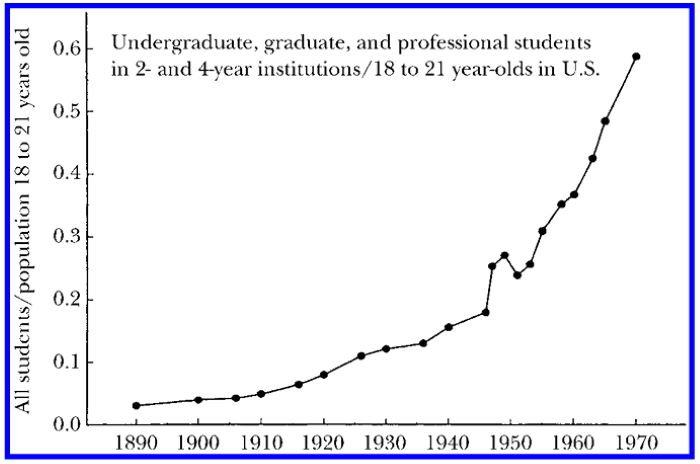
The formative period of higher education in the United States, while not one of enormous growth in the enrollment rate, nonetheless contains an impressive increase. We graph in Figure 1 the number of individuals enrolled (either as undergraduate or graduate students) in institutions of higher education in the United States as a fraction of those 18 to 21 years old. Here, we include all institutions: college, university, professional, teacher training, and junior college.3 The nearly quadrupling of the higher education enrollment rate from 1940 to 1970 will be familiar to many readers.4 However, enrollment increased more than three-fold from 1910 to 1940 and by five-fold from 1890 to 1940.
The founding of institutions of higher education flourished in the decades just before 1900.5 From 1638 to 1819, only 49 institutions of higher education (40 of them private ones) were established in the United States. Then the pace began to step up. From 1820 to 1859, 240 more institutions (225 private) were established. The next 40 years witnessed the greatest expansion in the pre-1940 period with 432 colleges and universities (348 private ones) established from 1860 to 1899. In particular, there were 186 institutions (151 private) opened from 1860 to 1879 and 246 more (197 private) from 1880 to 1899. Then the number of new institutions being established began to fall off. From 1900 to 1934, only 200 institutions opened (165 private). The closing decades of the 19th century, therefore, were the high point in the founding of four-year institutions of higher education before World War II.
The reason for that peak in the founding of colleges and universities might be thought to be the Morrill Acts of 1862 and 1890. The 1862 act granted funds to existing and future states to endow universities and colleges that specialized in agriculture and the mechanical arts (Nevins, 1962). The 1890 act set up many of today’s historically-black universities and also provided income to the institutions set up by the first act. But overall, about five times as many private institutions as public ones were founded during the entire period, and private institutions, more so than the public ones, were disproportionately founded in the closing years of the 19th century.
Not only were relatively few institutions founded after the turn of the 20th century, but those that were founded in the 20th century have tended not to be as prestigious. The 1890s, for example, saw the establishment of Stanford, Chicago and the California Institute of Technology. But among the 35 private institutions in the top 50 universities in the 1999 rankings by U.S. News and World Report (see »http://www.usnews.com…), only three began college-level instruction in the 20th century and just one was founded after 1900. The three are the Carnegie Institute of Technology (later Carnegie Mellon University), established in 1900 with instruction beginning in 1905; Rice Institute (later Rice University), founded in 1891 with college-level instruction beginning 1912; and Brandeis University, founded in 1948. Brandeis is a special case. It was established, in large measure, because Jewish academics and students had long been discriminated against, because large numbers of Jewish scholars took refuge in the United States during the war, and because the Jewish community had amassed funds to found a great university. In the top 35 liberal arts colleges (all under private control), as ranked by U.S. News and World Report, just two were founded in the 20th century. They are Claremont McKenna College (1946) and Connecticut College (1915)—although Claremont is part of a college system that includes Pomona College founded in 1888.
Something fundamental changed around the turn of the 20th century, making the founding of new institutions of higher education, particularly private ones, more difficult. That change, we will contend, had much to do with barriers to entry stemming from the larger scale and widened scope that were needed to be competitive. Financial resources became of increasing importance and institutional reputation began to matter more.
Changes in the Industrial Organization and Political Economy of Higher Education
Changes in Scale
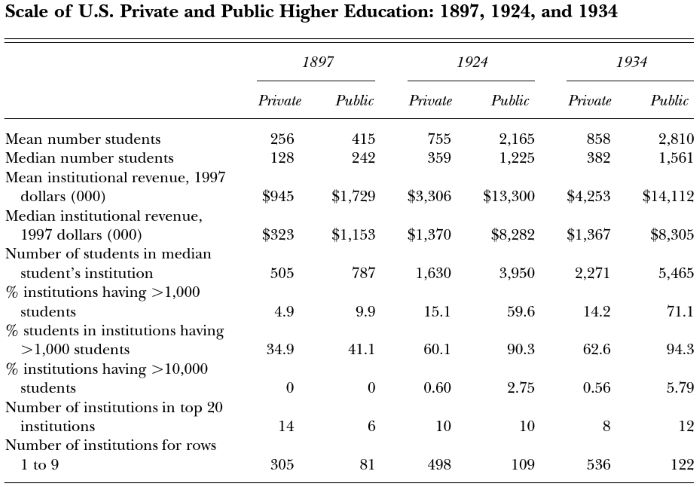
The size distribution of educational institutions altered considerably in the half-century before 1940, in both the public and the private sectors. The data we use to illustrate these points come from three cross-sections constructed for 1897, 1924 and 1934. The dates were chosen to span the period of interest.6 Several distributional measures are offered in Table 1 because the surveys we use disproportionately undercount small private institutions in 1897, and possibly in 1924 as well, whereas virtually all relevant public institutions were included in all years.
In 1897, the median private institution had 128 students and the median private student was in an institution with 505 students. In the public sector these two measures were 242 and 787. Thus, publicly-controlled institutions were, on average, larger than those in the private sector, but not very much larger—they were less than twice as large. By 1924 the average institution in both sectors had grown substantially, but public sector institutions had grown far more. The median private institution had 359 students in 1924 and the median student in the private sector was in an institution with 1,630 students. The public sector numbers were 1,225 and 3,950. For both statistics, the average public sector institution grew by about 1.8 times that of the private sector, and the relative growth of institutional revenue is about the same order of magnitude. By 1924, private sector institutions had about three times as many students than their private counterparts. During the 1924 to 1934 decade, the scale of both public and private institutions continued to increase and public sector institutions continued to grow a bit faster than those in the private sector. We also compared the 1924 and 1934 figures using a matched sample of the same institutions, with similar results.
The evolution of scale as it played out in public and private institutions can be summed up easily enough. The ratio of the median number of students in public and private institutions, per institution, was 1.89 in 1897, but 3.41 in 1924 and 4.09 in 1934. The ratio for the size of the institution of the median student was 1.56 in 1897, but 2.42 in 1924 and 2.41in 1934.
A major change in relative magnitudes, therefore, occurred sometime between 1897 and the 1920s. By 1924 public sector institutions of higher education already included many large, research-oriented universities.7 Interestingly, in more recent data the absolute sizes of institutions have continued to rise, but the public/private ratios have not changed greatly. In 1990–94, the median number of students per institution was 1,579 in the private sector and 8,181 in the public sector, producing a ratio of 5.18.8 Since the 1930s, four-year public sector institutions have grown at a somewhat greater rate than those in the private sector, but not by much. Scale effects, however, have continued to advance for institutions in both sectors.
Table 1 also presents some measures relating to the upper tail of institutions by number of students. In 1897 almost 5 percent of all private institutions had more than 1,000 students and about 10 percent of the public institutions did. They contained about 35 percent of all students in the private sector and 41 percent of those in the public sector. In 1924, 15 percent of private institutions had more than 1,000 students but about 60 percent of public institutions did. About 60 percent of all private sector students were in these large schools, but more than 90 percent of the public sector students were. Six publicly controlled institutions appear among the top 20 by student population in 1897, ten in 1924, and twelve in 1934. Today, only 5 percent of all private sector institutions have more than 10,000 students, whereas 42 percent of public sector institutions do. All of today’s top 20 institutions by size are in the public sector.
Changes in Scope
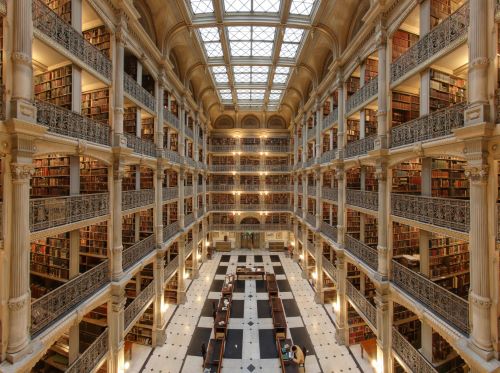
The formative years of American higher education from about 1890 to 1940 saw some major changes in the scope of institutions, including the emergence of the research university, the demise of independent professional institutions, and the decline of independent schools of theology and denominational institutions in general.
For most of the 19th century, American institutions of higher education were centers of learning, not research. That began to change in the latter part of the nineteenth century with the founding of the Johns Hopkins University (1876), the first dedicated research center in the United States, followed by Clark University (1889), the first U.S. institution with only a graduate program, and the University of Chicago (1892) (Veysey, 1965). Universities had long existed in Europe, where they took several forms: the classical studies of British universities, the scientific training of French grand ecoles, and the graduate and research institutes of Germany. The modern university of the New World, however, was a different creature than its European counterpart, for it served a far broader clientele of students and the state, yet increasingly strove to be a research center. The American research university was to become a melding of all the components of higher education, serving a multitude of functions simultaneously.
The distinction between a ‘‘university’’ and a ‘‘college’’ has long been somewhat ambiguous. Many institutions incorporated as ‘‘universities’’ were actually liberal arts colleges, like Taylor University, whereas some colleges have been true universities for some time, like Boston College. The U.S. Office of Education offered the definition that universities are ‘‘institutions in which there is considerable stress on graduate instruction, which confer advanced degrees in a variety of liberal arts fields, and which have at least two professional schools that are not exclusively technological’’ (American Council on Education 1960, p. 11). A ‘‘university,’’ then, would appear to be a department store of higher education, combining the specialized disciplines with the broader ones of the past and adding the various professional subjects like law, medicine, dentistry, pharmacy, theology, and even business.
But the modern university is far more than a collection of higher education services brought together under one roof. It is a production center in which the research of one part enhances the teaching and research of the other parts. The ‘‘university’’ form was an organizational innovation enabling the exploitation of technical complementarities among its various components. Although the public sector did not have a corner on universities, it did, from the beginning of the period we are studying, have a disproportionate share of them. In 1897, for example, the publicly-controlled sector had 43 percent of all universities but only 13 percent of all institutions of higher education. The fact that the publicly-controlled sector was disproportionately established in the university, research-oriented form gave it a substantial edge on the private sector in the period to 1940, when the overall share of (non-preparatory) college students enrolled in ‘‘universities’’ increased from 42 percent in 1897 to 59 percent in 1934.
Certain universities had, as well, the capacity to bestow reputation on new divisions in untried areas, such as business, and in older disciplines plagued by claims of quackery, as in the case of medicine. Medical schools were increasingly vulnerable in the late nineteenth century with the advent of stricter state licensing, designed in part to replace the ‘‘art of healing’’ with science. Their numbers thinned further in the wake of a 1910 Carnegie commission report known as the ‘‘Flexner Report’’ after its author Abraham Flexner which severely criticized many of the 155 medical colleges in the United States and Canada (Starr, 1982). Thus, the university came to combine the features of a department store, an integrated knowledge-production factory, and a brand name.
As independent professional institutions declined, professional schools associated with universities increased, although only in the case of medical schools is the causation unambiguous. At the turn of the 20th century, 48 percent of students training to be lawyers, dentists, pharmacists, and doctors (of both humans and animals) attended professional schools that were independent of any other institution of higher education. At this time, professional schools often did not require the students to have had a college degree, and many had not previously attended college at all (Abbott, 1988). But by 1934, only 19 percent of professional students were attending independent schools. In 1897, the U.S. Office of Education surveyed 185 independent professional schools: 103 medical schools, 22 law schools, 32 schools of dentistry, and 28 that taught pharmacy. By 1934 the number of independent professional schools had dropped to 58, of which 27 were law schools. Over this time, the share of all students in higher education attending independent professional schools fell from 15.5 percent of all students to just 1.9 percent of all students.
The transformation of professional training occurred in several steps. Increased specialization and the greater need for rigorous scientific training enhanced the returns to formal schooling. Thus, the first step in the transition was the shift from informal apprenticeships to formal education in specialized schools, although in the case of law and engineering, apprenticeships continued well into the 20th century. The schools providing the credentials were increasingly required to have state approval, research facilities, and an unassailable reputation. Professional education was eventually deemed to require an undergraduate education. But even as late as 1934 only 10.7 percent of the 122 law schools listed in The College Blue Book (1933), a contemporary guide to colleges, required four years of college; 67.2 percent required one semester to two years of college, and 9.0 percent required just a high school diploma. Medicine was transformed, as well, by the campaign of the American Medical Association in the 1910s to rid the nation of ‘‘sub-standard’’ medical schools, and the regulatory response of the various states.
Thus the clinical, informal, and apprenticeship programs of the past gave way, in almost all the professions, to scientific, formal, and school-based training. Moreover, the schools in which the training was delivered increasingly became parts of universities rather than existing as separate independent institutions. The research university had enormous advantages in terms of its productivity, and because it lent its reputation to occasionally-sullied professions.
As universities emerged as major research centers and as the classical curriculum of liberal arts colleges gave way to a more modern one, higher education became secularized (Hofstadter and Hardy, 1952, ch. II). In 1897, 13 percent of all surveyed institutions of higher education were independent theological schools (having 4.3 percent of all students), but by 1934 10 percent were (with 1.5 percent of students). The decline is even greater (17 percent versus 11 percent) if the independent professional schools are omitted for they, too, decreased in numbers. The change took place in a variety of ways. Many transformed themselves into non-sectarian, liberal arts colleges. Others merged with universities to become non-denominational divinity schools. Many simply vanished. The demise in denominational institutions that trained ministers was furthered by the decreased relative demand for their services. The ratio of the average salary of Methodist and Congregational ministers to that of all wage earners in manufacturing fell from 1.81 in 1890, to 1.68 in 1900, 1.44 in 1910, and 1.38 in 1925 (Historical Statistics, 1975, series D 781, 793). But another part of the secularization of colleges was due to the triumph of the scientific method and other aspects of secular thought that were incompatible with religious doctrine.
The Shift Toward Public Higher Education
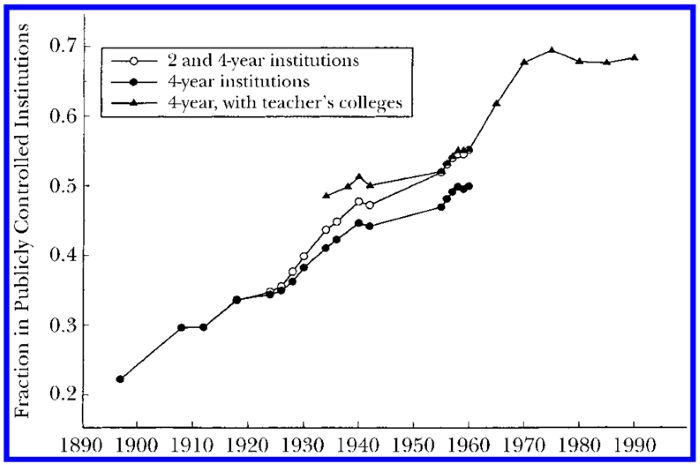
The discussion has already mentioned in a number of places that the publicly controlled portion of higher education expanded substantially in the 1890 to 1940 period. Figure 2 shows various measures of the fraction of students in the publicly controlled sector from 1897 to 1990. From 1897 to 1940 the fraction of students in publicly-controlled institutions increased from 0.22 to about 0.5. Then from just before World War II to 1990, the fraction rises from about 0.5 to 0.67.9
The full century would then appear to involve an increase from around 0.22 to 0.67, although the group of included schools changes in large measure because the functions of the schools did. Teacher-training institutions, which before 1940 were often normal schools with a two-year curriculum, later became part of state universities. Even those that continued to specialize in teacher training began to grant a bachelor’s to a majority of their graduates. If one includes two-year institutions, mainly community colleges, the share of total enrollments accounted for by publicly controlled institutions reaches 78 percent by 1994 (U.S. Department of Education, 1996).
What accounts for the relative growth of the public sector? We will offer two complementary interpretations. The more novel explanation is that the application of the scientific method and the increased division of labor and specialization in higher education disproportionately benefited certain types of institutions. Those that had access to research funds, were initially large and diverse, were non-sectarian, and had reputation and a long purse were in the best position to prosper from the changes. More public sector institutions than private sector ones were so situated and thus flourished and expanded in the wake of the changes to the structure of knowledge that shook higher education from around 1880 to 1910.
The reason the changes to the structure and diffusion of knowledge favored public sector institutions returns us, in part, to the notion that they created complementarities between research and teaching. Institutions of higher education that engaged in research activities were suddenly able to provide teaching services at lower cost—they could spread their research base to benefit their teaching. Small liberal arts colleges, independent professional schools, and sectarian institutions were at a competitive disadvantage.
Of course, certain private institutions also gained from the technological changes that affected higher education at the start of the formative period. Some were research and graduate institutions prior to the changes at the turn of the century, like Johns Hopkins and Chicago, while others were well positioned to make the transition with large endowments and long lists of prosperous alumni. However, the importance of pre-existing reputation and the immense scale required to become a first-rate university after this technological shock is highlighted by the trivial number of leading private universities founded in the 20th century.
An alternative, simpler explanation for the rise in the public share of higher education enrollment concerns the high school movement that swept much of the nation between 1910 and 1940 (Goldin, 1994, 1998). In 1910, less than 10 percent of young Americans graduated from secondary schools, but by the mid-1930s about half did in most states outside the South. Not only did the supply of high school graduates increase, but the increase was greater in states in the midsection of the country and on the West Coast that earlier had well-functioning public higher education institutions (Goldin and Katz, 1997).
As secondary school enrollments soared, a smaller fraction of high school graduates went on to college, but a larger fraction of all youths did. The new group of high school graduates differed from the old by background, aspirations, and geography, and more of the newer graduates were less able to afford private school tuition. Differences in the cost of college attendance between public and private sector institutions of higher education were already substantial in this period. The average (list) in-state tuition plus fees for undergraduates at public sector institutions in 1933 was $61 ($753 in 1997 dollars), as compared with $265 ($3,272 in 1997 dollars) in the private sector. The overall difference in the costs of attending public versus private institutions was further enlarged by the higher average room and board costs in private schools (College Blue Book, 1933). However, even at this time, the returns to college were high. Goldin and Katz (1999) find, using a unique data set from the 1915 Iowa State Census, that the estimated return to a year of college from a standard log earnings regression was over 12 percent a year for young workers— similar to estimates for the 1990s. Thus, there was a substantial inducement to continue with college, particularly if the youth was in a state with a high-quality, inexpensive public system. The combination of an increased relative demand for a more practically oriented curriculum and the lower income levels of a larger fraction of high school graduates shifted out the relative demand for public institutions of higher education.
Explaining Political Economy Changes at the State Level
Providing Public Goods at the State Level
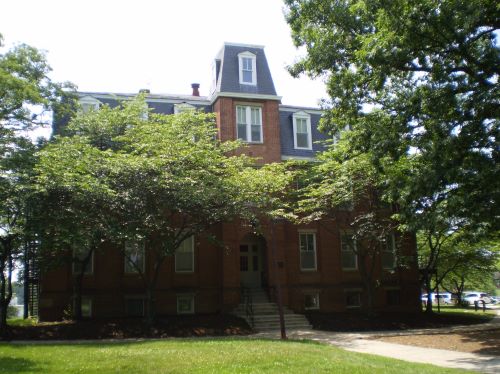
Even before the historic Morrill Act passed in 1862, four-fifths of the existing 33 states outside the Northeast had at least one state-controlled institution of higher education; the exceptions were Arkansas, Illinois, Kentucky, Oregon and Texas. Of the nine states of New England and the Middle Atlantic region, only Vermont and Pennsylvania had state institutions of higher education in 1860. To be sure, some of these institutions of higher education were not yet offering undergraduate instruction in 1860—for example, the Universities of California and Minnesota were established before 1860 yet neither had an operating undergraduate program until 1869—but here we are focusing on the date of establishment (see also Brubacher and Rudy, 1958). The early state institutions were often established to produce educated personnel needed to staff teaching at the lower grades. Most were set up using federal land grants, similar to those of the 1862 Morrill Act. Although many state institutions contained a liberal arts college indistinguishable from those in the private sector, almost all eventually produced services of value to the state apart from teaching undergraduates and training school teachers. A primary reason for state support to higher education was to provide ‘‘public goods.’’ State institutions in the 19th century were more practically and, often, more scientifically oriented than were their private counterparts, in large measure because of the commitment to provide goods and services of value to citizens and local industrial interests.10
Even though many state institutions were founded before the 1862 Morrill Act and another large group was established with that legislation, state funding on a per capita or per student basis was measly until the late 19th century, when scientific findings became important in agriculture, mining, oil exploration, manufacturing, and construction. In states having a concentration of economic activity by industry or by product, the public sector often invested heavily in training and research in these industries. Wisconsin subsidized work on dairy products, Iowa on corn, Colorado and other western states on mining, North Carolina on tobacco, and Oklahoma and Texas on oil exploration and refining.11 State institutions of higher education often contained professional training institutes, such as in engineering, and graduate programs in various sciences, including those pertaining to agriculture. Rosenberg and Nelson (1993) discuss the role of both state and private universities in producing ‘‘local public goods’’ before the 1940s but shifting to defense and health-related work later. With this broad portfolio, the state institutions of higher education attained the status of ‘‘university’’ to a greater extent than did those in the private sector. They had all the component parts of the university— the liberal arts college, the graduate programs, and the professional schools—and they also had access to the research funds of the state at a time when such funds were less available elsewhere.
Among the most striking differences between the curricula of public and private institutions in the formative period concerns engineering. In 1908, among all public sector college and university students, fully 30 percent were in engineering programs and 60 percent of all engineering students nationwide were being educated in public sector institutions. Although by 1930 the share of all public sector students who were in engineering dropped to 15 percent, the fraction of all engineers enrolled in public institutions rose to 66 percent. Engineering students were, quite obviously, being produced primarily by the public sector. In only a handful of states was there any private sector institution enrolling engineers, and just three states in 1930—Massachusetts, New York, and Pennsylvania—enrolled 62 percent of all private sector engineering students. Because two-thirds of engineers were being trained in the public sector in 1930, the geographic dispersion of engineering students came mainly from those enrolled in the public sector. The public sector had a great interest in producing engineers for governments that disproportionately hired them. In 1940, for example, before the large increase in defense spending, almost 25 percent of all ‘‘engineers’’ were working directly for the government, and the figure excludes those working in the private sector under government contract.
Public sector institutions of higher education generally became more highly specialized over time. New Mexico, Colorado, South Dakota, and Montana, in that order, founded mining schools from 1859 to 1921. The majority of the state schools established in the early part of the 20th century were for blacks or women, or were teaching, technical, and industrial institutes, such as the Lowell Textile Institute in Massachusetts. Although states continued to found institutions that had broad local support, they were no longer the universities of the earlier period.
Differences among States
State support for public higher education increased greatly from the late 1890s to 1940, measured either by state spending on higher education or by the growth of enrollments in publicly-controlled institutions relative to all enrollments, or to the college-aged population. For example, total expenditures of state higher-education institutions increased from 5.1 percent to 11.0 percent of state and local government spending from 1902 to 1940 (Historical Statistics, 1975, series Y 684-85, F 1). But public funding for higher education and access to public colleges and universities varied substantially among states throughout the period. The greatest levels of support were found in the Pacific, Mountain, and West North Central states, and the lowest levels of state support were found in New England and the Middle Atlantic states.
Since many of the differences in state support for higher education persist today—the cross-state correlation between (log) state and local government spending per capita on higher education in 1929 and that in 1994 is 0.44—it is interesting to explore the determinants of state support in the formative years. We will focus our discussion here on 1929, a year chosen to examine state differences before the expansions of federal support for higher education and just prior to the substantial effects on state and local budgets of the Great Depression. We have also done analyses of cross-state differences in 1924 and 1934, which lead to similar conclusions.
In 1929, state and local government subsidies to higher education averaged $1,089 per 1000 persons across the 48 states, which was 6 percent of total state and local government spending. Almost 95 percent of state and local support for higher education went to publicly-controlled institutions; only in New York (Cornell) and New Jersey (Rutgers) was state support of privately controlled institutions of significance. State and local spending on higher education per 1000 inhabitants ranged from a low of $458 in New England to a high of $2,057 in the Mountain states. Enrollments in publicly-controlled institutions averaged 3.19 per 1000 inhabitants: from 0.82 in New England to 6.04 in the Mountain states and 6.09 in the Pacific states. What explains these substantial differences across regions and among individual states?
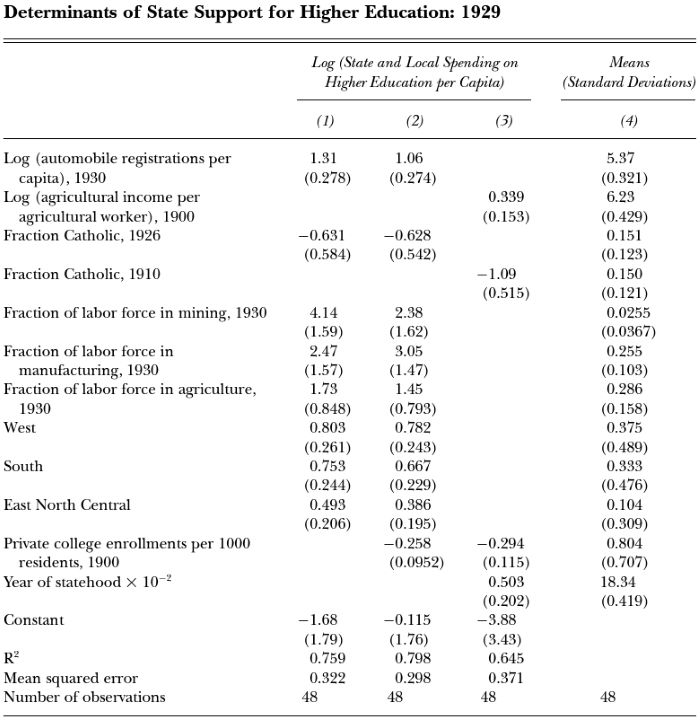
Table 2 explores the determinants of differences across states in (log) state and local spending per capita on higher education in 1929 in a regression framework. The public choice decision to provide support for higher education is likely to be affected by the level and distribution of wealth or income in a state, by community stability and homogeneity, and by the importance of industries that capture localized benefits of research at state institutions.
Weuse automobile registrations per capita in this period as a measure of both the level and distribution of wealth since it is, essentially, a count of the fraction of individuals wealthy enough to own a car. Thus it proxies for the share of voters sufficiently wealthy to believe their children were likely to attend college. Indeed, we found that automobile registrations per capita is a stronger predictor of state spending on higher education than either per capita property wealth or income per capita. Goldin and Katz (1997) similarly find that automobile registrations per capita is the best single predictor of state high school graduation rates during this period. Indeed, the illustrative regression in the first column of Table 2 indicates a strong positive relationship between automobile registrations per capita and state support for higher education. A one standard deviation increase (or 0.32) in registrations is associated with a 0.42 log point (52 percent) increase in state spending per capita on higher education.
The next variable in the first column of Table 2, percentage Catholic (which ranges across states from 0.2 percent to 50 percent in 1926), is highly correlated with the fraction of foreign-born citizens and the fraction of the population in urban areas in a state. All these variables provide measures of the degree of religious and ethnic heterogeneity in the area and thus the potential for conflict in voting on public expenditures.
The shares of employment in mining, manufacturing, and agriculture are also positively related to state support for higher education. The relationship might emanate from the ability of these sectors to lobby for research, extension, or experiment station support at state institutions. It might, as well, come from the belief of state legislators that the social return on public expenditures was high and that it would accrue to residents of states that had highly concentrated agriculture, unique manufacturing outputs, and idiosyncratic engineering and mining needs. The next few variables are dummies for geographic regions, which use the Northeast as the base group. The Northeast has substantially and significantly lower public support for higher education than do other regions—that is, the coefficient on every other region is positive and significant—even after including controls for wealth and industrial structure.12
We add, in column 2, an additional variable to account for the historical importance of private colleges and universities. Enrollments in privately controlled institutions in 1900 had a significant depressing effect on state public support for higher education in 1929. In fact, the raw correlation between state spending on higher education in 1929 and the importance of private universities in the state at the start of the 20th century is 00.69. The magnitude of the effect is also large; the difference between private college enrollments per 1000 residents in Massachusetts and Iowa in 1900 (3.35 to 0.99) implies a difference in per capita spending on higher education between the two states of 61 log points or 84 percent.
State initial conditions around 1900 are strong predictors, by themselves, of state support for higher education in 1929. In column (3) we include four variables for these initial conditions—the year of statehood, agricultural income per agricultural worker in 1900, fraction Catholic in 1910, and private college enrollments per 1000 residents in 1900—and find very strong predictive ability for them.
To sum up, newer states with a high share of well-to-do families and scant presence of private universities in 1900 became the leaders in public higher education by 1930. They remain so today. The tradition of stronger private universities and lower support for publicly-controlled universities in the Northeast also continues to the present—the correlation of public college enrollments per capita in 1994 with private college enrollments per capita in 1900 is 00.56.
Consequences of the Increased Public Higher Education Enrollments in the Formative Period
One reason for interest in the growth of public higher education is to understand its impact on overall rates of going to college. We therefore explore the factors that affected college-going at the state level from 1897 to 1931. Because college students attend school both in and out of their state of residence, we use data on the college attendance of individuals by their state of residence. Such data have been collected by the federal government at various intervals since the 1870s.13 The percentage of students attending college who enrolled in their state of residence was 76.4 percent in 1897, 75.6 percent in 1923, and 80.3 percent in 1931.
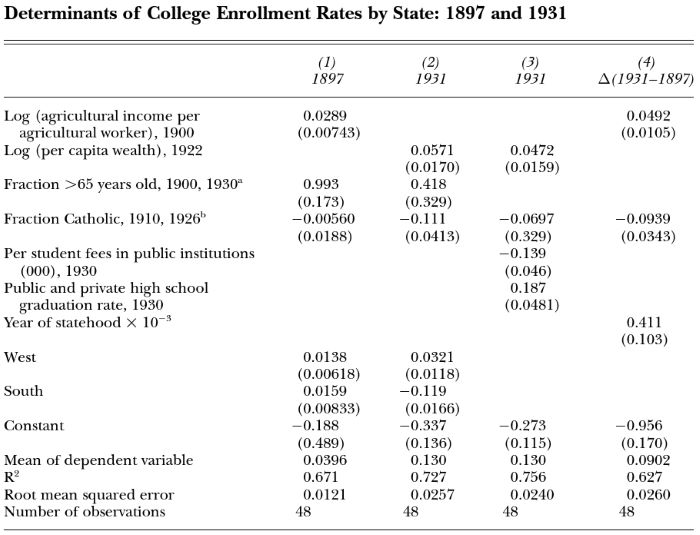
The dependent variable is the number of college students by state of residence as a fraction of those 18 to 21-year-olds in the state. In the first three columns of Table 3 we present levels regressions for 1897 and 1931, and in the final column we show a change regression across the entire period as a function of various initial conditions. The variables included in the first three columns of Table 3 are motivated by a model of individual income maximization and by a public choice framework (Goldin and Katz, 1997). The first two variables are proxies for per capita income or wealth. During this period, the fraction elderly can be thought of as a measure of community stability. A higher percentage elderly in a state could indicate that they are more connected to their community either because the area was not recently settled or because the elderly have not migrated from it.14 The fraction Catholic can be thought of as capturing the importance of the foreign-born and/ or urban population, and thus telling something about the homogeneity of the electorate.
Per capita material resources—whether proxied by per capita wealth or agricultural income per farm worker (data availability dictates which is used)—was an important and strong stimulant to college enrollment, as is our measure of community stability, although less so for 1931. In our geographic variables, which should again all be considered relative to the Northeast, the West becomes a more impressive, positive outlier toward the end of the period, and the South emerges as a negative outlier.
We are able, for 1931, to measure the impact of public sector tuition and fees on the college enrollment rate. The estimates in column 3 imply that a decrease in public sector tuition and fees of one standard deviation in 1931 ($84) increased the college enrollment rate of state residents by 1.2 percentage points (or 9 percent of the mean level). This estimation, moreover, holds constant the fraction of youth graduating from secondary school in the state.
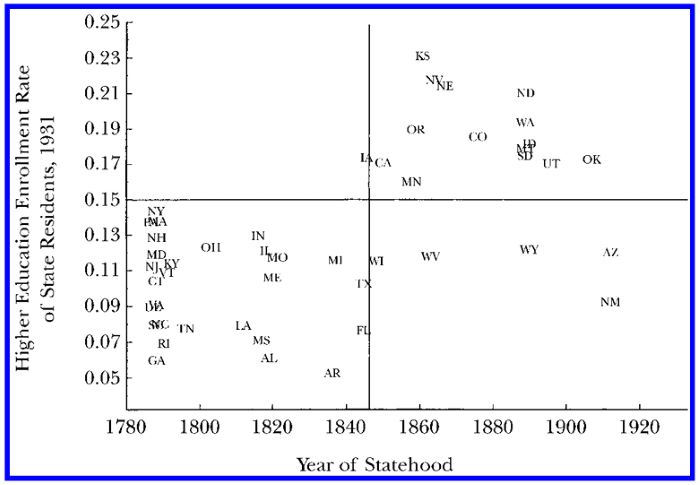
Finally, the regression in column 4 of Table 3 indicates that states with later dates of statehood had more rapid growth in college enrollment rates from 1897 to 1931, even conditioning on initial agricultural income per worker and percent Catholic. Figure 3 shows the positive relationship between the year of statehood and the college enrollment rate that existed by 1931.15 After drawing in the two axes somewhat carefully, the states fall into essentially two quadrants, with a few outliers. Those that were early entrants had low levels of college enrollment. Among them are many in New England and the Middle West known for their early and strong commitment to primary education. The late entrants had high levels of college enrollment and include those in the Great Plains and Far West. Many of these states were leaders in the high school movement, but the differences in the case of college enrollment are more extreme. Not only did the late entering states have a large proportion of their young population eligible to attend college, but they also funded higher education so well that they achieved a college-going rate about double that of the group in the other quadrant. Many in the early-statehood quadrant also had a substantial proportion of their youth prepared to enter higher education—like Indiana, Maine, Massachusetts, New Hampshire and Ohio—but their state support of higher education was more meager.
Concluding Remarks: Persistence of Change in Higher Education
Our interest in the history of higher education is motivated by its relevance for understanding the patterns of today. Many of the key features of (four-year) higher education in the United States today—the large average size of its institutions; the coexistence of liberal arts colleges and research universities; the substantial share of enrollment in the public sector; the long-lived and vibrant private sector; and the differences in per capita resources provided by the various states—were shaped during a formative period from 1890 to 1940.
Indeed, it appears that patterns set in the early decades of the 20th century are persisting today. States in which private institutions had a substantial presence in the more distant past, and in which higher education received scant public support, continue to exhibit similar patterns. Those that entered the union earliest had, in the early 20th century and continue to have today, lower public college enrollment rates and lower state subsidies for higher education. Even in 1994, the cross-state correlation of public college enrollments per capita with year of statehood is 0.70. The 1994 level of in-state tuition at four-year public universities has a correlation of 00.59 with year of statehood. Similarly, the simple correlation of public college enrollments per capita in 1994 with private college enrollments per capita in 1900 is 00.56. That is, states with high private university enrollments around 1900 continue to provide less support per capita for public institutions of higher education and have lower public college enrollment rates.16 States having high levels of public support per capita for higher education in the 1920s continue to do so today. The cross-state correlation between (log) state and local government spending per capita on higher education in 1929 and that in 1994 is 0.44. The crossstate correlation between public college enrollments per capita in 1929 and that in 1994 is 0.61. The weight of history appears to matter considerably in state-level indicators regarding higher education.
Data Appendix
The data used in this paper draws heavily upon three sources: the Annual Report of the Commissioner of Education for 1897 (Report of the Commissioner of Education, 1897), and two Biennial Surveys done by the U.S. Office of Education for the years 1922–24 and 1932–34 (Biennial, 1922–24; Biennial, 1932–34). Each of the three sources contains relatively similar information on the number of students in various groups (for example, by sex; by level such as preparatory, undergraduate, and graduate; by type such as collegiate and professional) and revenue sources (for example, student fees, government grants and private gifts). Total revenues do not include additions to endowment, which are listed separately. Students exclude those in summer school, correspondence courses, extension, and military drill.
Institution level data similar to those we have used are available in printed form for most years from 1890 to 1938. The 1934 data set includes 853 institutions, 711 privately controlled and 142 publicly controlled. That for 1924 has 790, with 677 private and 113 public. In the 1897 there were 534 universities and colleges listed separately from professional and theological schools, and technical institutes. We added the last three groups, but only for institutions not on the original list. (The added institutions have information on students and faculty only.) The final 1897 sample contains 821 institutions, of which 717 were private and 104 public. We did not code institutions that were junior colleges in the given year. Separately listed independent teaching colleges and normal schools were not coded.
The 1924 listing contains the ‘‘date at first opening,’’ which can be different from the date of founding, and was checked against the date of first instruction in American Council on Education (1960). We linked the 1924 schools to those in 1934 and used several other guides, such as The College Blue Book (1933), for the histories of institutions that changed city or name, or merged with or split off from others. Of the 790 schools in 1924, 695 were linked to institutions on the 1934 list. Among those that were not theological seminaries and independent professional schools in 1924, the linkage rate is 91.5 percent.
Except in the case of the historically-black institutions, we were able to find virtually all—if not all—publicly-controlled institutions known to have existed in each of the three years: 1897, 1924, and 1934. In both 1897 and 1924 many of the publicly controlled, historically-black institutions of today were not listed, although some were. We have traced the histories of these institutions and believe they were omitted from the college list because they were correctly categorized as teaching colleges or industrial institutes. Thus we are reasonably certain that the publiclycontrolled sample is complete. We used the historical information in American Council on Education (1960) for our institutional categorization and were helped by the contemporaneous information in The College Blue Book (1933).
In the data underlying Figure 2, an attempt was made (by us and by the government) to include the total number of regular, residential students at the college level without duplication. That is, all collegiate, graduate, and professional students, but not preparatory students (nor summer school, correspondence school, and special students), should be in both the numerator and the denominator. The U.S. Department (Office) of Education appears to have revised its totals at various intervals. The totals that appear in Historical Statistics (1975, series H 706) are those corrected figures. The contemporaneous enrollment numbers for the publicly controlled institutions appear to be correct. The implied data for the privately controlled institutions (obtained by subtraction) are considerably less stable over time than they probably were and we have therefore adjusted them by interpolation. These adjustments slightly affect some of the totals for 1897 to 1912. Publicly controlled institutions include those at the state, city, and national levels.
Appendix
Endnotes
- Our focus is on four-year higher education. We omit two-year colleges, as well as independent teacher training institutions, since most of the students at such colleges were there for only two years. Before the 1940s, many professional schools (teaching law, medicine, veterinary medicine, pharmacy, and dentistry) had programs for which the bachelor’s degree was not a prerequisite—nor was it granted at the termination of the program. Students in professional programs must, therefore, be grouped with allprebachelor’s. See Goldin and Katz (1998) for a more detailed presentation of the statistical materials in this paper.
- Very few national learned societies disappeared. An important one that did was the American Social Science Association (founded 1865), which was less a learned society than it was an advocacy group. It gave rise to a host of professional organizations on crime and social service, as well as to the American Historical Association and the American Economic Association. Having thus exhausted its membership, it disbanded in 1912 (Kiger, 1963, p. 234–35).
- A few data issues should be mentioned. The figure overstates the fraction who ever attended a two- or four-year institution of higher education, because some in professional or graduate school had already earned their first degree and they and others may have attended for more than four years. Prior to 1955, enrollment was cumulated over the year, but after that date it is given as ‘‘opening fall enrollment.’’ The difference, according to the U.S. Department of Education, is about 10 percent. Because of this implicit overcounting, the data in Figure 1 should not be strictly interpreted as the percentage of the relevant cohort who attended college. However, possible duplication of students within a university— for example, a student registered in two divisions—was accounted for in the original collection of the data by the U.S. Department (Office) of Education.
- The college enrollment rate stabilized in the 1970s before continuing its upward advance in the 1980s and 1990s. Data from the October Current Population Surveys, since 1972, provide a direct measure of the share of new high school completers ages 16 to 24 who enrolled in college in the fall after completing high school. The share of recent high school graduates enrolled in college showed little change from 49.2 percent in 1972 to 49.3 percent in 1980. But this measure of the enrollment rate then increased steadily in the period of rising relative earnings of college graduates and reached 65 percent in 1996 (U.S. Department of Education, 1998, table 7-1).
- We use a sample of the 921 four-year institutions of higher education (778 private and 143 public) in existence in 1934 and surveyed then by the Office of Education. The group excludes independent teacher-training institutions, but includes independent professional schools. We define the ‘‘founding’’ date as the year in which the institution opened or had the ability to grant the bachelor’s degree, not necessarily the year of establishment. Most branch institutions of state universities are not counted as separate institutions.
- Let us offer a few comments on the data we use. The Biennial 1938–40 was the last to present data for separate institutions. Summaries by state exist in most years, but include junior colleges before 1934 and after 1942. We exclude all independent teacher-training institutions and two-year colleges. In the discussion of this section we also exclude students who were in the preparatory departments of higher educational institutions. In 1897, for example, about 35 percent of all students in liberal arts colleges and universities were not yet admitted to undergraduate rank but were, rather, preparatory students; the figure had declined to 13 percent in 1924. See the Data Appendix for further information.
- We do not have good measures of total research funds at either the institutional or state levels, but we do have expenditures for ‘‘organized research separately budgeted’’ for public and private institutions (not including teachers colleges, normal schools, and junior colleges). In 1934, 2.4 percent of all educational and general expenditures for privately-controlled colleges went for ‘‘research,’’ defined in this manner, and 9.3 percent did in the publicly-controlled sector. The highest private percentage by state was New Jersey, because of a state-supported, privately-controlled institution—Rutgers University. Source: 1932/34 Biennial, table 22.
- The 1990–94 data (a five-year average) are from the CASPAR (Computer Aided SciencePolicyAnalysis and Research Database System) from which were excluded junior colleges, normal schools, independent teaching colleges, independent professional schools, and independent theological institutes.
- Again, let us offer a few thoughts on data and alternative studies. O’Neill (1971, table 3) presents enrollments (in credit hours) in the public and private sectors from 1930 to 1968 and finds little upward trend until around 1952. However, her data include teacher-training institutions and once that adjustment is made,are consistent with our data. Hight (1976) computes for 1927to1972, a statistic apparently similar to that in the triangle line in Figure 2, but which also includes two-year institutions. However, because Hight’s data do not contain the previous 30 years, the conclusion reached is somewhatdifferent from ours. Hight emphasizes the relative increase of the public sector after 1947 rather than seeing the greater increase before, evident in our data.
- It is not clear why public financial support for higher education meant direct provision of higher education by a state-run institution. In only two states—New Jersey and New York—did the state grant substantial funds to privately-controlled institutions (Rutgers and Cornell) for agricultural and other research and training. One potential reason for the lack of public support to private research endeavors may be that research is a case where it is difficult to draw up an enforceable contract for the provision of high-quality work, and so the incompleteness of contracts may argue for direct state control, along the analytical lines suggested by Hart, Shleifer and Vishny (1997).
- Another reason offered for state funding of university research is that it has localized positive spillovers that increase economic growth and industrial development in the state, even if the research does not directly relate to the current industries. See Jaffe (1989) for evidence on positive spillover effects of university research on state patenting rates and industrial research and development.
- Interestingly, some plausible explanatory variables turned out to have insignificant effects. We attempted to control for overall state spending by using total state and local government spending in 1932 to explain public higher education spending in 1929, but it did not materially affect the magnitude or statistical significance of any of the effects of other included variables. The results of regressions along these lines are similar when the share of the population of college age (15 to 24 years old) is added as an explanatory variable; the variable tends to be insignificant. It is sometimes argued that states that brought the university ‘‘to the people’’ through extension services created support for their public institutions. We find, however, that extension funding per capita is not very related to per capita expenditures on public higher education. Many southern states like Alabama and South Carolina had high levels of extension expenditures. It would appear that extension services often substituted for, rather than complemented, on-site education and training. Extension funding was just $0.12 per capita ($1.08 in 1997 dollars) in 1921, whereas total public expenditure on higher education was $1.09 per capita ($10.23 in 1997 dollars) in 1929 (U.S. Department of the Interior, 1923; Biennial 1928/30).
- See Hoxby (1997a, b) for an interesting use of these data to track the evolution of a national market in education.
- In 1910 the states with the highest percentage elderly were in New England, where out-migration of the young produced the result. But there is considerable variation among the other states and our results on secondary schooling are robust to including a dummy variable for New England. Poterba (1997) finds a contrasting result using recent data: a more rapid growth in the percentage elderly is associated with lower growth in K–12 spending per child. Hoxby (1998) finds that per pupil spending at the school district level is positively related to the elderly share of the population in 1900 and 1910, but negatively related in 1990.
- The positive impact of later statehood may originate, in part, in the greater generosity of the federal government over time in granting lands to new states for institutions of higher education. Almost all states entering after the ‘‘original fifteen’’ (the usual thirteen plus Maine and Vermont) received 72 sections of land for a ‘‘seminary’’ or ‘‘university.’’ Some western states entering after 1862 received yet more, to compensate for Morrill land grants received by previous states (Gates, 1968). Note that the relationship shown in Figure 3 holds even if we exclude the ‘‘original fifteen.’’ Quigley and Rubinfeld (1993) discuss the relationship between state higher education more recently and the year of statehood.
- Data on public college enrollments and in-state tuition levels for 1994 are from U.S. Department of Education (1996).
References
- Abbott, Andrew. 1988. The System of Professions: An Essay on the Division of Expert Labor. Chicago, IL: The University of Chicago Press.
- Allen, Garland. 1979. ‘‘The Transformation of a Science: T. H. Morgan and the Emergence of a New American Biology,’’ in The Organization of Knowledge in Modern America, 1860–1920. Alexandra Oleson and John Voss, eds. Baltimore, MD: Johns Hopkins University Press.
- American Council of Learned Societies. 1996. American Council of Learned Societies Directory of Constituent Societies, 1996–97. New York, NY: American Council of Learned Societies.
- American Council on Education.1960. American Universities and Colleges. Mary Irwin, ed. Washington, D.C.: American Council on Education.
- Bates, Ralph. 1965. Scientific Societies in the United States. Cambridge, MA: The MIT Press.
- Biennial [years]. The full citation is generally: U.S. Bureau of Education. [years]. Biennial Survey of Education [years]. Washington, D.C.: G.P.O.
- Brubacher, John S. and Willis Rudy. 1958. Higher Education in Transition: An American History: 1636–1956. New York, NY: Harper and Brothers Publishers.
- College Blue Book. 1933. The 1933 College Blue Book. Huber William Hurt and Harriett-Jeanne Hurt, eds. Hollywood by-the-Sea, FL: The College Blue Book.
- Economic Report of the President [year]. The full citation is: Council of Economic Advisors. [year]. The Economic Report of the President. Washington, D.C.: G.P.O.
- Gates, Paul W. 1968. History of Public Land Law Development. Washington, D.C.: G.P.O.
- Goldin, Claudia. 1994. ‘‘Appendix to: How America Graduated from High School: An Exploratory Study, 1910 to 1960.’’ National Bureau of Economic Research-Development of the American Economy Working Paper, No. 57, June.
- Goldin, Claudia. 1998. ‘‘America’s Graduation from High School: The Evolution and Spread of Secondary Schooling in the Twentieth Century.’’ Journal of Economic History. June, 58, pp. 345–74.
- Goldin, Claudia and Lawrence F. Katz. 1997. ‘‘Why the United States Led in Education: Lessons from Secondary School Expansion, 1910 to 1940.’’ National Bureau of Economic Research Working Paper, No. 6144, August.
- Goldin, Claudia and Lawrence F. Katz. 1998. ‘‘The Shaping of Higher Education: The Formative Years in the United States, 1890 to 1940.’’ NBER Working Paper no. 6537, April.
- Goldin, Claudia and Lawrence F. Katz. Forthcoming, 1999. ‘‘Human Capital and Social Capital: The Rise of Secondary Schooling in America, 1910 to 1940.’’ Journal of Interdisciplinary History. XXIX, pp. 683–723. Handlin, Oscar and Mary F.
- Handlin. 1970. The American College and American Culture. New York: McGraw Hill.
- Hart, Oliver, Andrei Shleifer and Robert W. Vishny. 1997. ‘‘The Proper Scope of Government: Theory and an Application to Prisons.’’ Quarterly Journal of Economics CXII, November, pp. 1127–1161.
- Hight, Joseph E. 1976. ‘‘The Demand for Higher Education in the U.S. 1927–72; The Public and Private Institutions.’’ Journal of Human Resources. X, December, pp. 512–520.
- Historical Statistics. 1975. The full citation is:U.S. Department of Commerce, Bureau of the Census. 1975. Historical Statistics of the United States from Colonial Times to 1970. Washington, D.C.: GPO.
- Hofstadter, Richard and C. DeWitt Hardy. 1952. The Development and Scope of Higher Education in the United States. New York: Columbia University Press.
- Hoxby, Caroline M. 1997a. ‘‘The Changing Market Structure of U.S. Higher Education.’’ Unpublished paper. Harvard University.
- Hoxby, Caroline M. 1997b. ‘‘How the Changing Market Structure of U.S. Higher Education Explains College Tuition.’’ National Bureau of Economic Research Working Paper No. 6323, December
- Hoxby, Caroline M. 1998. ‘‘How Much Does School Spending Depend on Family Income? The Historical Origins of the Current School Finance Dilemma.’’ American Economic Review. May, 88, pp. 309–14.
- Jaffe, Adam B. 1989. ‘‘Real Effects of Academic Research.’’ American Economic Review. December, 79, pp. 957–70.
- Kaplan, David L. and M. Claire Casey. 1958. Occupational Trends in the United States, 1900 to 1950. Bureau of the Census Working Paper No. 5. Washington, D.C.: G.P.O.
- Kevles, Daniel. 1979. ‘‘The Physics, Mathematics, and Chemistry Communities: A Comparative Analysis,’’ in The Organization of Knowledge in Modern America, 1860–1920. Alexandra Oleson and John Voss, eds. Baltimore, MD: Johns Hopkins University Press.
- Kiger, Joseph C. 1963. American Learned Societies. Washington, D.C.: Public Affairs Press.
- Kiger, Joseph C. 1982. Research Institutions and Learned Societies. Westport, CT: Greenwood Press.
- Kimball, Bruce A. 1992. The ‘‘True Professional Ideal’’ in America: A History. Cambridge MA and Oxford UK: Blackwell Publishers.
- Kuznets, Simon, Ann Ratner Miller and Richard A. Easterlin. 1960. Population Redistribution and Economic Growth: United States, 1870–1950. Vol. II. Analyses of Economic Change. Philadelphia, PA: The American Philosophical Society.
- Levine, David O.1986. The American College and the Culture of Aspiration, 1915–1940. Ithaca, NY: Cornell University Press.
- Nevins, Allan. 1962. The State Universities and Democracy. Urbana, IL: University of Illinois Press.
- Oleson, Alexandra and John Voss. 1979. The Organization of Knowledge in Modern America, 1860–1920. Baltimore, MD: Johns Hopkins University Press.
- O’Neill, June. 1971. Resource Use in Higher Education: Trends in Output and Inputs, 1930 to 1967. Berkeley, CA: Carnegie Commission on Higher Education.
- Poterba, James M. 1997. ‘‘Demographic Structure and the Political Economy of Public Education.’’ Journal of Policy Analysis and Management. 16, pp. 48–66.
- Quigley, John M. and Daniel L. Rubinfeld. 1993. ‘‘Public Choices in Public Higher Education,’’ in Studies of Supply and Demand for Higher Education. Charles T. Clotfelter and Michael Rothschild, eds. Chicago, IL: University of Chicago Press.
- Report of the Commissioner of Education [year]. Full citation is: U.S. Department of the Interior. Office of Education. [year] Report of the Commissioner of Education for [year]. Washington, D.C.: G.P.O.
- Rosenberg, Nathan and Richard R. Nelson. 1993. ‘‘American Universities and Technical Advance in Industry.’’ CEPR Publication No. 342, Stanford University.
- Ross, Dorothy. 1979. ‘‘The Development of the Social Sciences,’’ in The Organization of Knowledge in Modern America, 1860–1920. Alexandra Oleson and John Voss, eds. Baltimore, MD:Johns Hopkins University Press.
- Rossiter, Margaret W. 1979. ‘‘The Organization of the Agricultural Sciences,’’ in The Organization of Knowledge in Modern America, 1860-1920. Alexandra Oleson and John Voss, eds. Baltimore, MD: Johns Hopkins University Press.
- Starr, Paul. 1982. The Social Transformation of American Medicine. New York, NY: Basic Books. Statistical Abstract [year]. The full citation is: U.S. Department of Commerce. [year]
- Statistical Abstract of the United States. [year]. Washington, D.C.: G.P.O.
- U.S. Bureau of Education. 1909. Statistics of State Universities and Other Institutions of Higher Education Partially Supported by the State for 1908. Bulletin, 1908. No. 8. Washington, D.C.: G.P.O.
- U.S. Bureau of Education. 1913. Statistics of State Universities and Other Institutions of Higher Education Partially Supported by the State for 1912. Bulletin, 1912. No. 33. Washington, D.C.: G.P.O.
- U.S. DepartmentofCommerce.1930.Religious Bodies: 1926. Volume I: Summary and Detailed Tables. Washington, D.C.: G.P.O.
- U.S. Department of Education, National Center for Education Statistics. 1996. Digest of Education Statistics 1996. Washington, D.C.: G.P.O.
- U.S. Department of Education, National Center for Education Statistics. 1998. The Condition of Education 1998. Washington, D.C.: G.P.O.
- U.S. Department of Health, Education, and Welfare. 1961. Opening (Fall) Enrollment in Higher Education, 1960. Analytic Report by Edith M. Huddleston. Washington, D.C.: G.P.O.
- U.S. Department of the Interior, Bureau of Education. 1924. Statistics of State Universities and State Colleges for 1923. Bulletin, 1924, No. 26. Washington, D.C.: G.P.O.
- U.S. Department of the Interior, Bureau of Education. 1923.Statistics of Land-GrantCollegesby L. E. Blauch. Bulletin, 1922, No. 34. Washington, D.C.: G.P.O.
- U.S. Department of the Interior, Office of Education. 1934. Residence and Migration of College Students by Frederick J. Kelly and Betty A. Patterson. Pamphlet No. 48. Washington, D.C.: G.P.O.
- Veysey, Laurence R. 1965. The Emergence of the American University. Chicago: The University of Chicago Press.
Originally published by the Journal of Economic Perspectives 13:1 (Winter 1999, 37-62), Harvard University, under and Open Access license.
